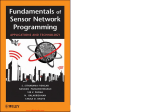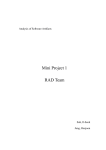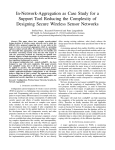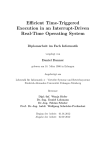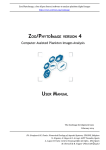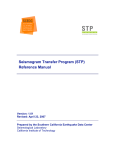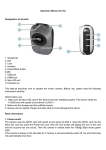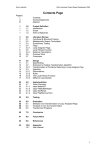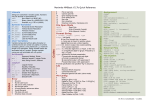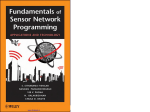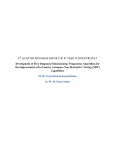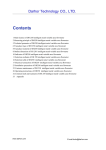Download Guided Test Generation for Finding Worst
Transcript
Guided Test Generation for Finding Worst-Case Stack Usage in Embedded Systems Tingting Yu Department of Computer Science University of Kentucky Lexington, KY, 40506, USA [email protected] Myra B. Cohen Department of Computer Science & Engineering University of Nebraska - Lincoln Lincoln, Nebraska, 68588, USA [email protected] Abstract—Embedded systems are challenging to program correctly, because they use an interrupt programming paradigm and run in resource constrained environments. This leads to a class of faults for which we need customized verification techniques. One such class of faults, stack overflows, are caused when the combination of active methods and interrupt invocations on the stack grows too large, and these can lead to data loss and other significant device failures. Developers need to estimate the worst-case stack usage (WCSU) during system design, but determining the actual maximum value is known to be a hard problem. The state of the art for calculating WCSU uses static analysis, however this has a tendency to over approximate the potential stack which can lead to wasted resources. Dynamic techniques such as random testing often under approximate the WCSU. In this paper, we present S IM S TACK, a framework that utilizes a combination of static analysis and a genetic algorithm to search for WCSUs. We perform an empirical study to evaluate the effectiveness of S IM S TACK and show that S IM S TACK is competitive with the WCSU values obtained by static analysis, and improves significantly over a random algorithm. When we use only the genetic algorithm, S IM S TACK performs almost as well as the guided technique, but takes significantly longer to converge on the maximum WCSUs. I. I NTRODUCTION Modern embedded systems are highly concurrent, memory, and sensor intensive, and run in resource constrained environments. They are often programmed using interrupts to provide concurrency and allow communication with peripheral devices. This combination of resource constrained, interrupt driven execution makes embedded software prone to several specific classes of runtime faults, such as those caused by worst-case execution or long interrupt latency, by timing violations and/or by stack overflows. Stack overflows, the subject of this paper, is a memory fault that occurs when the stack usage grows until it reaches and overlaps with another section of memory.1 Stack overflows can cause catastrophic software crashes resulting in data corruption, loss of return addresses or both [11]. For example, a stack overflow failure shut down a German railway station [1], and the unintended acceleration of the 2005 Toyota has been recently identified as being caused by this type of fault [7]. Therefore, engineers must ensure that the maximum allowable stack size will not be exceeded prior to 1 Stack overflow should not be confused with stack-based buffer overflows which result from vulnerabilities in programs (e.g., improper boundary check). software deployment through the identification of worst-case stack usage (WCSU), an undecidable problem. Usually during design time, the engineer will allocate a specific maximum stack size, based on his or her approximation for the system WCSU. A stack that is set too small is likely to be overrun, yet one that is set too high, will waste valuable resources. This trade-off is important, but WCSUs in embedded systems are difficult to identify, isolate, and correct once violated. The stack size at a certain program point depends both on the executed program paths as well as interrupt service routines (ISRs), i.e. executing the maximum possible stack requires executing specific program paths in combination with particular interrupt interleavings. Static analysis and testing are the two commonly used approaches to approximate the WCSU. Static analysis estimates the WCSU by finding the paths pushing the maximum amount of data into the stack (e.g., adding up instructions such as pushes and pops along each path). These paths may involve both functions in the main program as well as multiple ISRs. Static analysis can be fast and effective at estimating WCSU for small devices with simple program structures [16], [18], [28]. As the complexity of programs increase, static analysis tends to overestimate the WCSU by conservatively abstracting program constructs and values from source code or binaries [19] and this affects its precision and applicability, and can waste on-chip RAM resources. Existing work that favors static analysis over testing [16], [28] argues that it is safe. However, our experiments demonstrate that the static analysis tools can still underestimate the results since they consider only certain aspects of the system such as enabling/disabling of interrupts, and use explicit operations and bounding on the number of interrupts. This type of dynamic information can only be obtained during runtime and can obfuscate static analysis. Although research to date has aimed to address some of these problems [24], static analysis also still requires user annotations in order to properly handle libraries, as well as to identify any non-standard set of interrupt locations. Testing, in contrast to static analysis, is more general, in that it eliminates the need for annotations, by simply attempting to dynamically generate test inputs and interrupt schedules that can cause the WCSU to occur. Since it is using runtime information, testing may produce more precise WCSUs than a static analysis approach, however, its results can be an underestimate because only a subset of scenarios 978-1-4799-7125-1/15/$31.00 ©2015 IEEE are explored. This problem is exacerbated for interrupt-driven software because the conditions required to achieve worst case scenarios involve specific timing relationships between the occurrence of different hardware interrupts [24], [36]. In this paper, we introduce S IM S TACK, an automatic testing framework meant to uncover WCSUs that is informed by the path information obtained from static analysis (SA). Specifically, S IM S TACK first utilizes existing static analysis tools to compute program paths and interrupt interleavings that potentially lead to WCSUs. S IM S TACK then uses a weighted genetic algorithm (GA) for test case generation to find inputs and interrupt arrival points that favor these paths and interleavings. In the case of infeasible paths or interleavings reported by the SA, S IM S TACK drives the GA towards different paths that produce a larger stack size. S IM S TACK runs on top of a full system simulator, which allows for control over, and observability of the interrupt mechanism. To evaluate S IM S TACK, we compare its results with static analysis and those of random test case generation. We also compare against a GA alone. Our results show that S IM S TACK is more effective for estimating WCSU than other testing approaches, increasing the WCSU over random by as much as 161%. It compares favorably with static analysis, and is also efficient, identifying WCSUs in significantly less testing time compared to a GA without the static analysis. The contributions of this work are: 1) A testing approach, S IM S TACK, for finding WCSUs in interrupt driven software that is informed by, and can assess, the the results of static analysis; and 2) An empirical study demonstrating the effectiveness of S IM S TACK. In the next section we provide some motivation and background on interrupt driven programs, WCSUs and genetic algorithms. In Section III we present SimStack, followed by a case study in Section IV. We then discuss some of our interesting results (Section V) and follow this with related work (Section VI), conclusions and future work (Section VII). II. M OTIVATION AND BACKGROUND We begin by providing definitions and notations used in this paper, and then present our motivating example, followed by background on weighted multi-objective genetic algorithms. ISR1 Stack Several dynamic test case generation techniques have been proposed. Regehr [27] uses a random approach and discusses a preliminary genetic algorithm to direct the search for interrupt schedules that cause the system to reach maximum stack size. This algorithm only considers stack size (as we will see, this is less effective than our combined approach) and does not consider nested interrupts. Eslamimehr et al. [19] use concolic testing to direct test input generation, while interrupts are issued based on time intervals. In prior work, we utilized a genetic algorithm for a similar embedded testing problem, that of finding worst-case interrupt latencies [36]. There we learned that a random approach may not be effective as a genetic algorithm; random can greatly underestimate the real worst-case time. It is also not as efficient as the genetic algorithm, because it may require hundreds to thousands of runs to uncover some extreme values, especially for programs with complex structures and contain nested interrupts. Despite suggestions of combining a static and dynamic approach [19], [28], we do not know of work that has taken this path. f1 ISR4 Heap Data, BSS Fig. 1: RAM layout for an Embedded System A. Problem Definition We denote an interrupt-driven program as P = MainISR1 ISR2 . . . ISRN , where Main is the main program and ISR1 , ISR2 , . . ., ISRN are interrupt service routines, and where subscripts indicate interrupt numbers, with larger numbers denoting lower priorities. Typically, P receives two types of incoming data: command inputs as entered by users and sensor inputs such as data received through specific devices (e.g., a UART port). An interrupt schedule specifies a sequence of interrupts occurring at specified program locations. In testing, the input data and an interrupt schedule for P together form a test case for P . In this work do not consider reentrant interrupts (interrupts that can preempt themselves); these are uncommon and used only in special situations [28]. We also assume that there is a finite lower bound on the inter-arrival times of interrupts. This is a reasonable assumption for embedded systems in practice [25]. Figure 1 illustrates a typical RAM layout for an interruptdriven embedded system (the gray area reflects the stack). Whenever a function or an ISR is called it will result in a new stack frame. It shows a current program execution path {f1 ->ISR1 ->...->ISR4 ->...}, where one function from the main program and two ISRs are on the stack, with A->B denoting the fact that B is called after the entry, but before the exit of A. A stack overflow occurs when are too many active functions in combination with running interrupts. The stack can grow downward into the heap or into the DATA/BSS sections which overwrites values and thus corrupts them. B. Static Analysis of Maximum Stack Size Static analysis for embedded systems is typically performed by constructing a control flow graph (CFG) and then examining all possible execution flows accounting for instructions that allocate stack space. Specifically, the instructions of interest include branches, calls, returns, loads, pushes, pops, and loads from and stores to the stack pointer. It is common for an embedded system to run ISRs with interrupts either enabled or disabled [28], so multiple ISRs can accumulate. Thus, the WCSU for an application is the maximum stack depth of Main plus the sum of the maximum stack depths of all ISRs. This can be computed using the formula: n WCSU = Depthmax (M ain) + Depthmax (ISRi ), i=1 where i is the interrupt number. This formula is conservative because it counts for preemptions that may never happen. To 1. main{ 2. ... 3. if( input < 10){ 4. setMotor1(); 5. } 6. else{ /*disable ISR2*/ 7. SREG = val; 8. setMotor2(); 9. } 10. } 11. ISR2(){ 12. ... 13. } 14. ISR1( non_interruptible){ 15. ... 16. i2cSend(ADDR, Length, Data) 17. } 18. i2cSend(...){ 19. for(i = 0; i < 10; i++) 20. i2cSendData[i] = * data++; 21. ... 22. check(data) 23. ... 24. } Fig. 2: Example of WCSU Over-estimation overcome this limitation, most existing analyses determine for each program point which interrupts are enabled or disabled. Imprecision can occur because of several reasons. First, without running the program being assessed, it is difficult to statically track the changes to the interrupt status, which is commonly done by modifying the status register (e.g., SREG) using variables instead of constants. Most tools include a pre-defined set of operations (e.g., cli and sei) where interrupts are commonly disabled/enabled. Interrupts that fall outside of this set must be annotated by the user. Second, interrupts are highly platform dependent so static analysis is not applicable in the case that the interrupt status is dynamically changed by other software components or by underlying systems at arbitrary system execution points. Third, with the complexity of these programs and the variety of interrupt sources, it is difficult for static analysis to reason about the possible interrupt interleavings for interrupt-driven embedded systems that typically use the priority preemptive scheduling policy [25]. This can become even harder or infeasible for static analysis if the priority is adjusted at runtime. Fourth, the value analysis used to determine stack usage of interrupt-driven code suffers when indirect function calls, memory accesses, stack pointer modifications, and data dependencies between the main program and ISRs occur. Finally, modern embedded systems (e.g., automative systems) tend to be integrated with libraries and encrypted object code from different vendors. Figure 2 shows a simplified snippet of code from our experiments, on which we ran three static analysis tools [5], [9], [32]. All three report the WCSU path Pw =<main->setMotor2-> ->ISR2->ISR1->i2cSend->check> This path overestimates the WCSU because line 7 disables interrupt 2, so ISR2 cannot be called inside setMotor2. While static analysis may track interrupt bits written with constant values, it is obfuscated when the interrupt register is written with a variable. This problem may be addressed by by more precise data-flow analysis, but it is unclear whether such analysis is applicable to interrupt-driven programs. In addition, the interrupt disabling/enabling operations may not be visible when calling encrypted third-party libraries. Such information can be observed only at runtime. C. Weighted Multi-Objective Genetic Algorithms S IM S TACK formulates the test case generation problem as a multi-objective optimization problem using a weighted fitness approach. In a genetic algorithm, a population of individuals are evolved iteratively over a series of generations using a set of genetic operators (crossover, mutation, selection). The fitness function determines which individuals are closest to the stated objective and this is used during selection and crossover to evolve the next generation. In a weighted GA, each objective in the fitness function is given a coefficient which is the weight for its fitness value [26]. The weights can be tuned to drive the application more towards one objective or another. Since a weighted GA can only find a single best solution, it is commonly applied to multi-objective problems where it is possible to prioritize or order the objectives in a meaningful way [26] As noted in Section I, the goal of S IM S TACK is to assess the WCSU produced by static analysis, while also constructing new test cases that compute different WCSUs if the paths reported by static analysis cannot be exercised. As such, we can use two objectives and prioritize them. The first (higher priority) objective is increasing the stack size. The second objective is path coverage. Note that weights can impact both effectiveness and efficiency of WCSU estimation (described in Section V). The weights can be empirically chosen to maximize effectiveness. For path oriented coverage, the state of the art fitness function comprises two measures: an approach level and a path distance [35]. When both of the metrics are 0 the desired test data has been found. The approach level records how many path sections (edges in the CFG) are missed by a particular input. Consider the example from Figure 2 and assume the target is the edge 3-4 for the true branch. If an input takes the false then the approach level is 1, otherwise it is zero. III. S IM S TACK We now present S IM S TACK. We begin with its architecture and then described the genetic algorithm in more detail. A. SimStack Architecture Figure 3 illustrates the overview of S IM S TACK. It is implemented on AVRORA, a simulator platform that supports programmable event monitoring and application profiling [32]. We use the simulator because it allows for control of the interrupts; it provides system level observability and controllability. The Execution Engine and Execution Profiler are builtin modules. We use the programming interfaces AVRORA provides to create three additional modules to support testing: an Interrupt Controller, a Test Case Generator, and an Event Observer. We re-use the interrupt controller and event-observer from prior work for this framework [36]. The Static Analyzer is optional. We can plug a variety of existing tools into this part of the framework. S IM S TACK is configurable so that we can, for example, disable static analysis (due to platform restrictions) and use only the GA portion of the test case generation instead. We can also disable the GA and use random test case generation. The input to S IM S TACK is an initial (possibly empty) test suite and a set of (optional) paths generated by the static analyzer module (if applicable). For each static path, the GA targets that path to evolve the test suite. When there are no static paths, the GA evolves using only information from the test suite in its fitness function. As test cases are generated, they are executed to determine fitness (described later in this Virtual Platform: Avrora Test Suite Fitness (WCSU) Test Case Generator (Genetic Algorithm) Updated Inputs Interrupt Controller Event Observer Execution Engine Execution Profiler Paths Static Analyzer Application Binary Fig. 3: SimStack Architecture section). To do this, the GA interacts with the execution controller. For example, when an interrupt arrival point specified in a test is detected by the event observer module, the execution engine pauses the current program execution and requests the interrupt controller to invoke a specific number of interrupts. The execution controller also issues opportunistic interrupts to force an ISR to be reentered. Upon completing a test execution, the test case generator is updated with new test cases. The profiler is then used to measure performance and stack usage based on bytes allocated on the stack. The GA iteratively generates a test suite until all static paths are tried. In the case where all paths are unreachable, S IM S TACK chooses a test suite that produces the largest stack size. Since the execution of the full-system simulator is timing deterministic, the generated test cases are repeatable. B. S IM S TACK Genetic Algorithm S IM S TACK’s genetic algorithm accepts five parameters: a time limit titer , a path reported by static analysis PSA , a set of existing test cases T C, a maximum stack size smax (optional), and constraints, C, that need to be enforced. The algorithm returns a set of new test cases N T C. If the program specifies the WCSU, the stopping point is set to the point when the WCSU is reached. It includes an alternative: iteration limits. If T C is empty then the initial population is random. Chromosome. The chromosome is a combination of input data (main program inputs and sensor device inputs) and an interrupt schedule (interrupt arrival points) that consists of all interrupts in the program. A gene in the chromosome is denoted as a triple (num, instr[wait,. . . ], data), where num is the interrupt number, instr is the instruction location where the first interrupt num is issued, and data is the sensor input data associated with interrupt num. The array following instr indicates the time interval wait (measured by instruction cycles) between two occurrences of interrupt num during a test execution. The total number of interrupt occurrences (i.e., the sum of the array length for each interrupt num ) interrupt density, i.e., the percentage of instruction cycles spent on handling interrupts in a test run. As suggested in random testing for interrupt-driven software [27], interrupts should be neither too sparse nor too dense. Our previous work [36] also showed that appropriately adjusting interrupt density can enhance testing effectiveness. Based on our empirical observations for the subject programs (Section IV), S IM S TACK chooses interrupt density 60%, i.e., the system spends 60% of its instruction cycles executing interrupt handlers. Fitness Function. The first objective, f1 , is the stack objective and is defined as worst case stack usage. This objective is used to drive GA towards executions that can produce larger stack size if the path objective cannot be met. The stack size is calculated during the execution of test cases. When an interrupt interval time defined in the chromosome is reached, its associated interrupt is issued. The second objective (i.e., path objective) is defined as covering paths reported by static analysis. The path objective is a minimization task, where the optimal solution has a fitness value of zero. The fitness value can be formulated as f2 = a+d/(d + 1), where a is approach level and d is the branch distance. Unlike the traditional approach level that considers only sequential programs, the approach level used in our technique also records path sections involving interrupt interleavings. In the example from Section II in Figure 2, suppose the executed path is Pe = {main->setMotor2->ISR1->i2cSend->check}. Since ISR2 is not invoked, the approach level for Pe is 1. If an interrupt is invoked but at a different preemption point (e.g., ISR2 is called after main but before setMotor2 ) the approach level for the test case is added by 1. When a test case misses the target path section, the branch distance measures the distance to the critical branch, where the critical branch is the branch where control flow diverged from reaching the target. Resuming the example from Figure 2, if the input takes the false branch at line 3, the distance is |input − 10|+k, where k is a failure constant. We use k=1 in S IM S TACK. If a statement is executed multiple times, the branch distance d is the minimum over all executions. The normalized branch distance is defined as d/(d + 1). A path distance is the sum of the branch distances along a test execution [13]. We treat the branch distance of an interrupt arrival as k (i.e., 1). Since the stack objective is a maximization task and we need to combine this with the path objective, we use the inverse of the normalized number [26] of bytes, b, allocated on the stack, therefore f1 = (1.001−b ). The combined fitness is: f = wb · f1 + wp · f 2, where wb and wp are the weights for the stack and path objective, respectively. In general, our intuition is that the larger stack size and smaller path deviation provide the best fitness. SA tends to overestimate the stack size, so generating a test that exercises the path may lead to more efficiently uncovering WCSU. In the example from Figure 2, suppose there are two test cases tc1 and tc2; wp and wb are 0.001 and 1 respectively. The tc1 exercises P1 =<main->isr2-> isr1->i2cSend->check> with input data 1. The stack size is 70, the path objective is 2.91, and thus the fitness is 0.962 (2.91*0.01+1.001−70 ). The tc2 exercises P2 ={main->setMotor2-> isr1->i2cSend->check} with input data 11. The stack size is 80, the path objective is 1.67, and thus the fitness is 0.94 (1.67*0.01+1.001−80 ). In this case, S IM S TACK favors P2 by comparing its fitness value to that of P1 . Both path objective and stack objective in P2 are closer to their optimized fitness values. However, the two objectives may be offset by each other under certain circumstances. For example, suppose there is a test case tc3 with input data 1. When P3 ={main->setMotor1-> ->isr2->isr1->i2cSend->check} is reached, the stack size is 100, the path objective is 1.91, and the fitness TABLE I: Initial Test Case Population C.S. Main ISR1 ISR2 tc1 128 (1,0x9c[22,88],‘a’) (2,0xbd[44,12],‘d’) tc2 ... ... ... tc3 64 (1,0xfa[57,11],‘z’) (2,0x12[20,33],‘a’) tc4 ... ... ... tc5 56 (1,0xad[33,20],‘c’) (2,0x90[42, 96],‘a’) tc6 ... ... ... tc7 225 (1,0xbc[80, 34],‘f’) (2,0x88[45, 32],‘n’) tc8 ... ... ... ISR3 (3,0x2b[82],‘m’) ... (3,0x4c[99],‘k’) ... (3,0x2d[93],‘l’) ... (3,0x12[33],‘x’) ... TABLE III: Result of a CrossOver Operation Sk. 162 128 131 144 101 120 95 114 Pt. 1.25 2.34 1.5 1.98 2.48 2.66 3.18 3.22 Fit. 0.45 0.87 0.78 0.64 1.24 0.98 1.31 1.02 TABLE II: Result of Test Case Selection C.S. Main ISR1 ISR2 tc1 128 (1,0x9c[98,88],‘a’) (2,0xbd[44,12],‘d’) tc4 ... ... ... tc3 64 (1,0xfa[57,11],‘z’) (2,0x12[20,52],‘a’) tc2 ... ... ... ISR3 (3,0x2b[82],‘m’) ... (3,0x4c[99],‘k’) ... Sk. 162 144 131 128 Pt. 1.25 1.98 1.5 2.34 Fit. 0.45 0.64 0.78 0.87 is 0.924 (1.91*0.01+1.001−100 ). In this case, P3 is favored over P2 in terms of their fitness values. However, The path deviation in P3 is larger than that of P2 . This indicates that the fitness relies on the weight assigned to each objective. Constraints. Constraints must be adhered to in order for the test cases generated by S IM S TACK to be valid. Although Regehr’s approach [27] may avoid spurious interrupts in random testing by setting interrupt mask bits, it does not consider other constraints such as the specifications for devices and interrupt frequencies. which may lead to violations of system semantics and cause undefined program behaviors. First, the sensor data accepted by a device must conform to the range defined in the device specifications. For example, the sensor data accepted by the UART port has to be in the ASCII table. Second, the number of interrupts N to be issued is generated in terms of the specified interrupt density. Specifically, T ·D N= , n ISRiwcet i=1 where D is the interrupt density, n the number of ISRs, and ISRiwcet is the worst-case execution time (WCET) for ISRi . S IM S TACK randomly generates N interrupts with different interrupt numbers to determine the time interval arrays in a chromosome. Third, each time interval in the array must at least as long as the minimum inter-arrival time for the associated interrupt. For constraints that cannot be determined statically, S IM S TACK checks these dynamically. For example, S IM S TACK checks hardware states (e.g., interrupt bits) and issues only interrupts that are allowable by the hardware. SimStack GA Example. To illustrate S IM S TACK’s GA we present an example. Let P = Main ISR1 ISR2 ISR3 . Suppose the WCSU path estimated by static analysis is {Main->f0->ISR3 ->f3->ISR2 ->ISR1 ->f1}. Table I shows the initial population consisting of eight randomly generated test cases. The column labeled Pt. shows the path objective. The maximum stack size values and fitness values are shown in the columns labeled Sk. and Fit, respectively. We use 8-bit addressing, and each number related to the time interval has been divided by 100 for simplification. After running these test cases, S IM S TACK selects the four best test cases in terms of fitness values; in the example, this includes the first four (shown in Table II). At this point, some of the C.S. Main ISR1 ISR2 ISR3 tc1 128 (1,0x9c[98,88],‘a’) (2,0xbd[44,12],‘d’) (3,0x2b[82,. . . ],‘m’) tc3 64 (1,0xfa[57,11],‘z’) (2,0x12[20,98],‘a’) (3,0x4c[99,. . . ],‘k’) ch1 128 (1,0x9c[98,88],‘a’) (2,0x12[20,98],‘a’) (3,0x4c[99,. . . ],‘k’) ch2 64 (1,0xfa[57,11],‘z’) (2,0xbd[44,12],‘d’) (3,0x2b[82,. . . ],‘m’) Sk. 162 131 180 156 Pt. 1.25 1.5 0.5 1.77 Fit. 0.45 0.78 0.33 0.49 Pt. 1.25 1.58 0.5 1.77 Fit. 0.45 0.66 0.36 0.49 TABLE IV: Result of a Mutation Operation C.S. Main ISR1 ISR2 ISR3 tc1 128 (1,0x9c[98,88],,‘a’) (2,0xbd[44,12],‘d’) (3,0x2b[82,. . . ],‘m’) tc3 64 (1,0xfa[57,11],‘k’) (2,0x12[20,98],‘a’) (3,0x4c[99,. . . ],‘k’) ch1 128 (1,0x9c[98,88],‘a’) (2,0x12[20,98],‘a’) (3,0x56[99,. . . ],‘k’) ch2 64 (1,0xfa[57,11],‘z’) (2,0xbd[44,12],‘d’) (3,0x2b[82,. . . ],‘m’) Sk. 162 144 176 156 wait points of ISRs have been updated (shown in bold font) in terms of the dynamic constraints, because interrupts cannot be invoked at the original interrupt arrival points (i.e., 22 for ISR1 and 33 for ISR2 ). Taking tc1 as an example, suppose it exercises path {Main->f0->ISR3 ->ISR2 ->ISR1 ->f1}. the first invocation of ISR1 is at the location 0x9c. Then the second invocation occurs after 9800 cycles of the execution, followed by the third invocation after 8800 cycles. Since tc1 misses the target f3, the path objective is 1.25. The stack size calculated is 162 bytes. Next, the GA performs a crossover between two pairs of chromosomes. We cross tc1 and tc3 using a 1-point crossover with a randomly selected division point (the crossover choice is flexible). Table III shows the results of the crossover operation on two parent chromosomes and the generated offspring. The double line between the third and fourth columns indicates the crossover point. The non-shaded areas represent genes in the first parent (tc1), and the shaded areas represent genes in the second parent (tc3). The rightmost column shows the fitness values of the chromosomes. Last, mutation is performed by altering either data or wait in a gene. Table IV shows the results for four chromosomes after the mutation operator has been applied (mutated elements in bold). Following mutation, the four test cases are executed. The rightmost column shows the resulting fitness values. IV. E MPIRICAL S TUDY To assess S IM S TACK we explore two research questions. RQ1: How does the effectiveness of S IM S TACK compare to those of the static analysis, a non-guided GA and a random testing technique? RQ2: How does the efficiency of S IM S TACK compare to that of static analysis and a non-guided GA? To answer the first research question, we use two weighting schemes for the fitness function of S IM S TACK and compare it to static analysis [27], and a regular GA without the guidance of path information. While testing and static analysis each have strengths and weaknesses, comparing them allows us to evaluate how testing can help static analysis in estimating WCSUs. The second research question explores to what extent using static analysis can impact the efficiency of S IM S TACK in terms of converging on a WCSU. TABLE V: Object Program Characteristics - - OS 875 - - 1 - HC 1,550 0.8 1 SS 2,088 - 0.8 (p) - 1.2 1 (p) - 0.004 (p) - SG 2,373 - - - - SPI TM3C - I2C TM1C - ADC INT2 201 341 UT1 INT1 LD UT0 NLoC SD TM1O App. Interrupt Source (frequency KHz) In Decreasing Order of Priority 1 0.06 8 (p) - - 1.4 - - - 1.4 - - - - - 22 (p) - 8 (p) 8 (p) - 2 - 8 (p) 1.4 0.4 0.5 (p) 0.06 10 (p) - As objects of analysis we chose five embedded system applications. The first two SMALLDEMO (SD) and LARGEDEMO (LD), are open source programs downloaded from GNU Savannah [2], [3]. We configured the UART interrupt handler in LARGEDEMO to make it preemptible; this allows us to study diverse interrupt behaviors. SMALLDEMO controls an LED with a PWM (Pulse Width Modulation) output. The PWM value is changed when timer TM1 is triggered. LARGEDEMO extends the basic idea of SMALLDEMO, but adds methods to adjust the LED brightness. Its main function accepts an operation mode (e.g., ADC, button, serial) and PWM values. O SCILLOSCOPE (OS), is an application adapted from the TinyOS distribution [4] which was extended as a lab assignment in a graduate embedded systems course at the University of Nebraska - Lincoln. It is a data-collection demo that periodically samples the sensors and broadcasts a message over the radio to a base station. We modified the default O SCILLOSCOPE to let it fetch both temperature and humidity values of a mote. We also let it use UART to transmit and receive data. Its timer TM3 controls the sampling rate. Every time the timer expires it signals a timer event and reads data via the Read<uint16_t> interface. It then issues an SPI interrupt that calls AMSend.send to forward the data to next hop. The results are relayed to PC via serial port UT0. H AND -M OTION C HESS (HC), is a student project developed in a microcontroller class at Cornell University [6]. It simulates the physical (hand) motions involved in playing chess without the need for a physical chess set. Its main function performs actions based on the motion values of two contact sensors that are used to detect the motion of players (e.g., the position of the hand on the chess board). INT1 and INT2 generate interrupts for the contact sensors. TM1 ensures a constant sampling interval of ADC conversion, and TM3 ensures that the cursor’s position on the chess board is updated. S URVEILLANCE S YSTEM (SS), is from a graduate-level wireless sensor network project at the University of Nebraska - Lincoln, It detects motion using MICAz and four CMOS cameras to achieve 360°coverage. The outputs of the IR sensors in the cameras are fed to ADC. TM1 ensures a constant sampling interval of ADC conversion, and TM3 is used to refresh the sensor status stored in the database. UT0 is used by users to send commands and receive messages. SPI monitors the radio for incoming data and sends it to the base station. Last S NUGGLZ (SG, is from a graduate-level embedded systems course project at the University of Nebraska - Lincoln. It implements code for motion detection by a hovercraft, and runs on microcontrollers with voltages 3.3V and 5V. Its main function (on the 5V processor) accepts three inputs as commands to control directions, and sends them to the 3.3V processor through the I2C bus for processing. UT0 and UT1 are a pair of ZigBee radios used to receive and send data. I2C sends commands from the 5V processor to the 3V processor. TM0 controls periodic task scheduling. Table V lists these programs and shows the numbers of lines of non-commented code they contain, and the interrupt sources utilized by the programs with priorities ranging from highest to lowest. The interrupt complexity (the number of interrupts, critical sections, and branches within critical sections) of these programs ranges from lowest to highest across the the programs. The numbers in the columns corresponding to interrupts denote interrupt frequencies (the inverse of interrupt inter-arrival time). The notation “-” indicates that an interrupt is not utilized by the corresponding program. The notation “(p)” indicates that the interrupt is preemptible for the corresponding program; interrupts not so marked are not preemptible. Our programs utilize various interrupt sources. INT1 and INT2 are external interrupt interfaces that can be used to attach non-built-in devices. TM1 and TM3 are compare timers that trigger two interrupts when each of the timers reaches two different compare values. TM0 is an overflow timer that triggers an interrupt when it reaches its top value. UT0 and UT1 are UART devices used to receive and send ASCII data through UART ports; interrupts are triggered when data is available. ADC is an analog-to-digital converter, and triggers an interrupt when a new value is converted. I2C is a two-wire interface that sets communications between two devices; interrupts are generated based on their events.SPI is simple but a faster alternative to I2C. The timer interrupts (TM1, TM3 and TM0) are periodic interrupts that are issued at a periodic interval. The other interrupts are non-periodic interrupts that can occur any time after being issued by their associated devices. A. Setting GA Parameters We heuristically chose 32 as an initial population size, and 16 as the population size in succeeding generations. The resulting new number of new test cases is 16. We used two weighting schemes for wb and wp . wb is is left at 1.0 for both versions, but the wp is set to either 0.01 or to 0.001. In the former case, the path objective has a higher importance than the latter one. In both versions the objective has a higher priority than the path objective. For selection, we configured the algorithm to select the best half of the population from which to generate the next generation; the selected chromosomes are retained in the new generation. The chromosomes are ranked, and evens and odds are paired, to generate offspring. We configured the algorithm to perform a one-point crossover by randomly selecting a division point in the chromosome. Smith et al. [30] conclude that mutation rates considering both the length of chromosomes and population size perform significantly better than those that do not. Thus, √ as suggested by Haupt we utilize a mutation rate of 1.75 λ l et al. [21], where λ is the population size and l is the the length of chromosome. Our object programs do not specify the maximum WCSUs. Thus, iteration limits govern the stopping points for S IM S TACK. In this study, we used time limits to control iteration limits. To compare the effectiveness of S IM S TACK to other techniques, we set a maximum time limit of 24 hours for all techniques including S IM S TACK; this lets us examine the relative effectiveness of the techniques when each is given the same amount of time. B. Variables and Measures Independent Variable. The independent variable is our technique. We have two weighings of S IM S TACK, S IM S TACK.01 and S IM S TACK.001 , In addition, we consider three additional techniques. The first technique that we consider is static analysis (SA). We use two existing open source static analysis tools, TOS - RAMSIZE that analyzes tinyOS applications [5], and a built-in stack analyzer in AVRORA that analyzes Atmel AVR machine code [32]. The TOS - RAMSIZE applies on OC and SS, and the tool in AVRORA applies on the rest of the subject programs. To make the static analysis more precise, we modified the tools so that they track the change of interrupt status caused by the modification of the status register when using constant values. The current implementation identifies only explicit interrupt operations (i.e., cli and sei). As such, these tools reported more precise results than their original implementations did on our subject programs. The second technique that we consider is S IM S TACKGA , and is used to evaluate the effects of employing static analysis to guide the search of GA. S IM S TACKGA is implemented based on the S IM S TACK framework (Figure 3), except that it does not apply static analysis (e.g., wp = 0). The fitness function involves only stack objective. The third technique, R ANDOM, is a random testing approach based on the approach presented in [27]. R ANDOM neither applies a GA nor static analysis; instead, it randomly generates test cases following static constraints, and randomly issues interrupts with the same interrupt density achieved by S IM S TACK. For example, if the average interrupt density for device number 5 when using S IM S TACK is 8%, R ANDOM randomly selects interrupt locations for device number 5 with interrupt density 8% during testing. Dependent Variables. We measure the effectiveness and efficiency of the foregoing techniques. To measure effectiveness, we report the WCSUs calculated by the SA and the testing techniques for a given amount of testing time. To measure efficiency, we report the time required for the SS and the GA based testing techniques to converge. We do not consider the efficiency of random testing because it did not converge on a WCSU during the test case generation process. C. Study Operation We implemented S IM S TACK and on AVRORA, by tailoring the algorithm described in Section IV-B. The GA part was implemented on top of the Java Genetic Algorithm Library (JGAL)2 . As noted in Section III-B, the number of interrupts in a test case are partially determined by the worst-case execution time (WCET) for each ISR. To calculate WCET, we use BOUND - T, a commercial static analysis tool that analyzes Atmel AVR machine code to compute the WCETs [22]. For each test case, we pass the sensor inputs to the devices. By 2 http://jgal.sourceforge.net utilizing the monitor features, we can monitor each instruction access such that whenever an interrupt location of interest is reached, this interrupt is issued. AVRORA provides an API forceInterrupt(num) that lets users force a specific interrupt to occur. For dynamic constraint checking, AVRORA allows us to monitor hardware states and wait times (determine whether it is possible to issue an interrupt). Calculating fitness values including stack size, approach level and path distance can also be done using monitoring features. To control for variance due to randomization we ran each of the techniques ten times. We used a Linux cluster to perform the executions, distributing each job on a distinct node. D. Threats to Validity The primary threat to external validity for this study involves the representativeness of our object programs. We controlled for this threat by studying programs developed on various types of microcontrollers (e.g., MicaZ and Atmel) and languages (e.g., nesC and C). The primary threats to internal validity involves the lack of a true oracle, and possible faults in the implementation of the algorithms and tools that we used to perform the evaluation. Given that the programs are non-trivial with loops and jumps, it is difficult to validate whether the faults are false WCSUs, therefore the ground truth cannot be determined. We have extensively tested our tools and verified their results against a smaller program for which we can manually determine the correct results. We also chose to use the well-established Avrora simulator to implement our algorithm. Note that changes in hardware states including preemption delays due to the cache can also affect the execution time of interrupts. We do not consider these factors because they can be implementation dependent. For example, the Atmega processor that we model does not use cache memory. However, to apply our proposed framework to test for WCSU in systems that utilize cache memory, existing techniques such as Evicting Cache Block-Union [12] can be integrated with our framework to estimate delays due to cache preemption. Where construct validity is concerned, there are other metrics that could be considered such as the costs of engineer time. Alternative metrics are left as future work. E. Results and Analysis 1) RQ1: Effectiveness: Figure 4 plots the effectiveness results (the stack size) on individual programs observed in our study. Labels on the horizontal axis reflect techniques. Each box reflects the effectiveness scores (WCSU – bytes allocated on the stack) measured across all ten runs of the given technique. Asterisks show the means and dark horizontal lines reflect medians. The horizontal dotted lines show the effectiveness scores of static analysis. We first compare the effectiveness of S IM S TACK (SS.01 and SS.001 ) to that of static analysis (SA). For SD and OS, S IM S TACK estimated the same results as those computed by the SA. In fact, all ten runs of S IM S TACK reach the WCSU estimated by SA. On programs LD, HC and SS, S IM S TACK estimated smaller WCSUs than those computed by SA. In all three programs, SA overestimated the results (see Section V). On SG, SA underestimated the WCSU (explained in Section V). These results indicate that S IM S TACK is effective and achieves the same effectiveness as static analysis for 80 60 40 20 0 SS_.01 SS_.001 SS_GA RAND 400 SS_.001 SS_GA RAND SS_.01 SS_.001 SS_GA RAND 500 400 12 1.5 400 SS_.01 SS_GA SS_.01 SS_.001 SS_GA L.D. SS_GA RAND S.G. 40 22 35 SS_.001 30 SS_.01 20 RAND 18 SS_GA S.S. 16 SS_.001 14 SS_.01 Time (minites) 200 24 100 SS_.001 S.D. 300 200 300 H.C. 0 Fig. 4: WCSU calculated by different techniques. The horizontal SS_.01 dotted line represents the static analysis WCSU SS_.001 SS_GA SS_.01 Comparing S IM S TACK (SS.01 and SS.001 ) and S IM S TACKGA (SS GA), on programs SD, LD and OS, S IM S TACKGA and S IM S TACK were equally effective in their best runs. However, on LD and OS, when averaging over the 10 runs, S IM S TACK was more effective than S IM S TACKGA . The improvement of S IM S TACK.01 was 4.5% and 1.8%, and that of S IM S TACK.001 was 4.5% and 1.6%. On programs HC, SS and SG, S IM S TACK.001 was more effective than S IM S TACKGA for each of the ten runs, with average improvement of 6.2%, 5.6% and 6.1%, respectively. These results indicate that the use of the SA did impact the effectiveness of S IM S TACK in estimating WCSU. This impact was more obvious as the complexity level increased. On the other hand, S IM S TACK.01 was less effective than S IM S TACK.001 on programs HC, SS and SG, with average improvement over S IM S TACKGA 0.9%, 2.8% and 3.5%. In fact, on HC and SG, the best run of S IM S TACKGA outperformed that of S IM S TACK.01 by 2.6% and 3.5%, respectively. These results indicate that the weights did impact the effective- 62 90 60 80 58 70 56 60 Time (minites) We next compare the effectiveness of S IM S TACK (SS.01 and SS.001 ) to that of R ANDOM (RAND). As shown in Figure 4, on all six programs, S IM S TACK was more effective in all runs than the best runs of R ANDOM. Taking SS.001 as an example, the average improvement for individual programs ranged from 9% to 161.8%. The lowest level of improvement (9%) occurred on LD, while the highest levels of (161.8% and 149.7%) occurred on HC and SG, respectively. SS_GA H.C. 54 programs of lesser complexity, but as the complexity increases S IM S TACK and static analysis diverge. SS_.001 100 110 O.S. 52 Stack Size (bytes) O.S. Time (minites) 0 SS_.01 10 100 3.5 200 300 180 140 100 Stack Size (bytes) 220 L.D. 8 RAND 6 SS_GA S.D. 3.0 SS_.001 2.5 SS_.01 2.0 20 15 10 Stack Size (bytes) ness of S IM S TACK. When the path estimated by S IM S TACK deviates from the one estimated by SA, larger weights to the path objective can negatively impact the effectiveness of S IM S TACK. On examination of the results in SS,we found that only 58% of path sections in the path estimated by S IM S TACK are identical to those estimated by SA, but in program LD, although the path sections estimated by S IM S TACK are not identical to those estimated by SA, the deviations occurred on only interrupt interleavings, and not on sequential code. The correlation between the path objective and stack objective is always positive during the test case generation process. In such cases, assigning a larger weight to the path objective can still be effective. SS_.01 SS_.001 S.S. SS_GA SS_.01 SS_.001 SS_GA S.G. Fig. 5: Time required to converge on WCSUs 2) RQ2: Efficiency: To address RQ2, we rely on Figure 5, which plots the time (measured by minutes) required for S IM S TACK and S IM S TACKGA to converge on WCSU across the ten sets of runs. We first measured the amount of time required to estimate WCSU on our object programs using static analysis; in no case did the analysis require more than one minute, and thus, the analysis was more efficient than the analysis conducted by other testing techniques. We next compare the efficiency of S IM S TACK(SS.01 and SS.001 ) to that of S IM S TACKGA . As Figure 5 shows, in all six programs, S IM S TACK required less time than S IM S TACKGA to converge. Taking S IM S TACK.001 as an example, the average savings ranged from 2.4% to 32.3% across ten sets of runs. This indicates that SA did impact the efficiency of S IM S TACK. When comparing S IM S TACK.01 and S IM S TACK.001 , for SD, LD and OS, S IM S TACK.001 required less time than S IM S TACK.01 to converge, with average savings 24.7%,34.3%, and 4.9% across ten sets of runs. However, on programs HC, SS and SG, S IM S TACK.01 was more efficient than S IM S TACK.001 across ten sets of runs, with average savings 3%,3%, and 11.2%. These results indicate that weights did affect efficiency of S IM S TACK. For only programs whose stack objective is positively correlated to the path objective, assigning larger weights to the path objective can enhance the efficiency of convergence. V. D ISCUSSION We first analyze the results that diverge between testing and static analysis. On program LD, SA overestimated the WCSU. SA assumes that the UT0 and TM1O can both exist on the stack at the same time because UT0 is preemptible. However, the worst-case execution time (WCET) of UT0 can never exceed the minimum inter-arrival time of the TM1O, meaning that TM1O can’t preempt UT0. In fact, the system cannot be proven to be stack safe by SA without reasoning about the WCET [28] and the priority preemptive scheduling [25]. This process requires manually creating abstract timing models, reasoning about possible event interleavings, handling dynamic priority adjustment, etc. On program HC, SA estimated a higher WCSU than S IM S TACK. On further examination of the program, we ascertained that the modified AVRORA identified only explicit interrupt disabling and enabling operations (e.g., cli, sei), as well as changing the SREG register using constant values (e.g., SREG = 0xff). However, the program writes a variable to the SREG register (e.g., SREG = val) to disable interrupts in several execution points. This operation can not be handled by SA. As such, the SA incorrectly assumed INT1 and INT2 are preemptible all the way along the execution path, hence it overestimated the WCSU. On program SS, SA overestimated WCSU for two reasons. First, when SPI is enabled, both Main and UART0 have data dependencies with SPI. For example, when the WCSU path is selected in M AIN with a shared variable defined in SPI, the WCSU path in UART0 cannot be executed because it also has a dependency with this variable. Second, there exists an indirect jump in the Main that refers to a memory address which can be determined only at runtime. Users have to annotate the target memory address and provide an estimated concrete value for the SA. SA cannot handle the indirect calls and jumps (e.g., virtual function tables, exceptions, device driver interfaces, and callbacks), because the target addresses are located in registers and thus will not be easily known until runtime. On program SG, the static analysis actually underestimated the WCSU, which was a surprise. The imprecision is caused by the stack alignment subtracting from the stack pointer in the assembly code. The modification of the stack pointer can affect the size of the stack, however, the SA does not handle explicit stack pointer modification, such as adding and subtracting contents stored in registers (this case occurred in SG), and using an address offset combining with the memory-mapped address. In addition, it is difficult to statically distinguish the writes to the stack pointer that create a stack, modify a stack, or switch to a new stack [28]. Underestimation by Testing. While we ascertained that SA overestimated the WCSUs on HC and SS, it does not guarantee that S IM S TACK did not underestimate the results. By further examining the two programs, we did find a new path in program SS that leads to a larger stack size. This path was not exercised by the S IM S TACK. A specific interleaving is required to change a branch condition in the ISR of UT0 to exercise that path. While S IM S TACK does not guarantee to find the true WCSUs (this is a fundamental limitation to testing-based approach), it can still help engineers assess the WCSUs estimated by SA. Reentrant Interrupts. The occurrence of reentrant interrupts is another factor that may cause underestimation in both SA and testing techniques, because interrupts are usually assumed to be non-reentrant in order to bound the analysis. In fact, reentrant interrupts occur in rare cases and are generally considered to be design faults [28]. On program OS, if reentrant interrupts were permitted, S IM S TACK would have obtained a higher WCSU. Specifically, this program uses a high-frequency preemptible timer interrupt TM1O, so the SPI preempted TM1O and executed its handler. Since AMSend.send doesn’t disable the SPI interrupt, the timer device requested its next interrupt causing TM1O to be reentered. The reason is that the execution time of the ISR of the SPI is longer than the minimum inter-arrival time TM1O. This indicates that testing can also be used to disclose such design faults. VI. R ELATED W ORK Static analysis to estimate WCSUs for interrupt-driven software [16], [17], [24], [28], has resulted in multiple open source and commercial tools [5], [31], [32], [34]. These techniques all suffer from the limitations of static analysis, including high rates of false positives and possible false negatives. For example, Bucur et al. [17] assume all ISRs are atomic and thus do not handle nested interrupts. There has also been work handling interrupts using dynamic analysis techniques [20], [27], [36], [37]. Gracioli et al. [20] propose a technique to trace interrupt behaviors; traces can be used to help debug control flow problems in the software. Our previous work tests for worst-case interrupt latencies by conditionally controlling interrupts at certain points [36]. None of the techniques attempts to address the WCSU problems. Regehr [27] uses a GA to estimate WCSU for one TinyOS program. This approach does not leverage static analysis. and enforces only constraints on preventing reentrant interrupts; it does not consider other constraints, such as minimum interrupt inter-arrival times. Furthermore, it studies only one program meaning the evidence provided is limited. VICE [19] estimates WCSUs using concolic testing to explore paths and event sequences in interrupt-driven programs. This approach does not consider runtime constraints. In addition, this technique is applied on the method level and does not handle dependencies between the main program and ISRs. Hybrid techniques to estimate worst-case execution time (WCET) include [14], [29]. Schaefer et al. [29] use a feedback mechanism, manually generating test cases to bridge the gap between testing and SA. More testing is performed if the outcome deviates from that of static analysis. Rapitime [8] is a commercial WCET tool that uses testing to extract timing for smaller program parts, and static analysis to deduce the final program WCET estimate from the program part timings. These techniques all focus on sequential software systems, and none provide support for interrupts or directly address WCSUs. There has been work on testing embedded systems using evolutionary algorithms [10], [15], [23], [33]. Iqbal et al. [23] model the environments of real-time embedded systems, to generate test cases reaching a system’s error states. Briand et al. [15] apply model-based stress testing to real-time systems using genetic algorithms. They encode chromosomes as task arrival times, and search for schedules that can cause the system to miss deadlines. These methods are based on software modeling and do not consider a system’s real runtime states. In contrast, our technique does not require source code annotation or modeling, and our inputs and interrupt schedules are generated under real system runtime environments. VII. C ONCLUSIONS AND F UTURE W ORK We have presented a hybrid testing framework, S IM S TACK, for use in estimating worst-case stack usage for interruptdriven embedded systems. Our framework is built top of the AVRORA system simulator which provides both controllability and observability. S IM S TACK uses static analysis to first identify a set of paths leading to WCSUs. It then attempts to cover each of these using a genetic algorithm. The fitness combines both a path objective and a stack objective, but is weighted towards the stack size. When a path is infeasible, the GA evolves the first objective alone. We conducted an empirical study to evaluate the efficiency and effectiveness of S IM S TACK. The study demonstrates that S IM S TACK can produce more precise WCSUs than static analysis alone and that it is more effective for estimating WCSUs than random testing or than a genetic algorithm which is not informed by static analysis. As future work we intend to extend S IM S TACK to consider more factors that may contribute to the effectiveness of estimating WCSUs, and to evaluate it on more subjects. We also intend to investigate using the results of testing to feedback into and improve the static analysis. VIII. ACKNOWLEDGMENTS This work was supported in part by NSF grants CCF1161767 and CNS-1205472. R EFERENCES [1] About the Altona Railway software glitch. http://catless.ncl.ac.uk/Risks/ 16.93.html#subj1, 2005. [2] AVR C Runtime Library – Large Demo. http://www.nongnu.org/ avr-libc/user-manual/group largedemo.html#largedemo src, 2007. [3] AVR C Runtime Library – Small Demo. http://www.nongnu.org/ avr-libc/user-manual/group demo project.html, 2007. [4] Oscilloscope application. http://www.tinyos.net/tinyos-2.x/apps/ Oscilloscope/, 2008. [5] A stack depth analysis tool for TinyOS. http://tinyos.stanford.edu/ tinyos-wiki/index.php/Stack Analysis, 2009. [6] Hand-motion chess. http://people.ece.cornell.edu/land/courses/ece4760/ FinalProjects/f2012/oaq3 cig23 rk447/oaq3 cig23 rk447/index.html, 2012. [7] Toyota’s killer firmware: Bad design and its consequences. http://www.edn.com/design/automotive/4423428/ Toyota-s-killer-firmware--Bad-design-and-its-consequences, 2013. [8] Rapita Systems. http://www.rapitasystems.com/products/rapitime, 2014. [9] Using static analysis to bound stack depth. http://www.cs.utah.edu/ ∼regehr/stacktool/, 2014. [10] N. Al Moubayed and A. Windisch. Temporal white-box testing using evolutionary algorithms. In ICSTW, pages 150–151, 2009. [11] D. M. Alter. Online stack overflow detection on the TMS320C28x DSP. Technical report, Texas Instruments, 2003. [12] S. Altmeyer, R. I. Davis, and C. Maiza. Cache related preemption delay aware response time analysis for fixed priority preemptive systems. pages 261–271, 2011. [13] A. Baars, M. Harman, Y. Hassoun, K. Lakhotia, P. McMinn, P. Tonella, and T. Vos. Symbolic search-based testing. In ASE, pages 53–62, 2011. [14] A. Betts and A. Donaldson. Estimating the WCET of GPU-accelerated applications using hybrid analysis. In ECRTS, pages 193–202, 2013. [15] L. C. Briand, Y. Labiche, and M. Shousha. Stress testing real-time systems with genetic algorithms. In GECCO, pages 1021–1028, 2005. [16] D. Brylow, N. Damgaard, and J. Palsberg. Static checking of interruptdriven software. In ICSE, 2001. [17] D. Bucur and M. Kwiatkowska. On software verification for sensor nodes. JSS, 84(10):1693–1707, 2011. [18] K. Chatterjee, D. Ma, R. Majumdar, T. Zhao, T. A. Henzinger, and J. Palsberg. Stack size analysis for interrupt-driven programs. In SAS, pages 109–126, 2003. [19] M. Eslamimehr and J. Palsberg. Testing versus static analysis of maximum stack size. In COMPSAC, 2013. [20] G. Gracioli and S. Fischmeister. Tracing interrupts in embedded software. In LCTES, pages 137–146, 2009. [21] R. L. Haupt and S. E. Haupt. Practical Genetic Algorithms. John Wiley, 1998. [22] N. Holsti, T. Lngbacka, and S. Saarinen. Using a worst-case execution time tool for real-time verification of the Debie software. In DASIA, 2000. [23] M. Z. Iqbal, A. Arcuri, and L. Briand. Empirical investigation of search algorithms for environment model-based testing of real-time embedded software. In ISSTA, pages 199–209, 2012. [24] D. Kastner and C. Ferdinand. Proving the absence of stack overflows. In SAFECOMP, pages 202–213. 2014. [25] J. Kotker, D. Sadigh, and S. A. Seshia. Timing analysis of interruptdriven programs under context bounds. In FMCAD, pages 81–90, 2011. [26] K. Lakhotia, M. Harman, and P. McMinn. A multi-objective approach to search-based test data generation. In GECCO, pages 1098–1105, 2007. [27] J. Regehr. Random testing of interrupt-driven software. In EMSOFT, pages 290–298, 2005. [28] J. Regehr, A. Reid, and K. Webb. Eliminating stack overflow by abstract interpretation. TECS, 4(4):751–778, Nov. 2005. [29] S. Schaefer, B. Scholz, S. M. Petters, and G. Heiser. Static analysis support for measurement-based WCET analysis. In RTCSA, pages 47– 56, 2006. [30] J. Smith and T. C. Fogarty. Adaptively parameterised evolutionary systems: Self-adaptive recombination and mutation in a genetic algorithm. In PPCN, pages 441–450, 1996. [31] StackAnalyzer: Stack Usage Analysis. http://www.absint.com/ stackanalyzer/index.htm, 2014. [32] B. L. Titzer, D. K. Lee, and J. Palsberg. Avrora: Scalable sensor network simulation with precise timing. In IPSN, pages 477–482, 2005. [33] M. Tlili, S. Wappler, and H. Sthamer. Improving evolutionary real-time testing. In GECCO, pages 1917–1924, 2006. [34] VerOStack – Static Worst-Case Stack Analysis. http://www.verocel. com/products/stack-analysis, 2014. [35] J. Wegener, A. Baresel, and H. Sthamer. Evolutionary test environment for automatic structural testing. Information and Software Technology, 43(14):841–854, 2001. [36] T. Yu, W. Srisa-an, M. B. Cohen, and G. Rothermel. SimLatte: A framework to support testing for worst-case interrupt latencies in embedded software. In ICST, pages 313–322, 2014. [37] T. Yu, W. Srisa-an, and G. Rothermel. SimTester: A controllable and observable testing framework for embedded systems. In VEE, pages 51–62, 2012.












